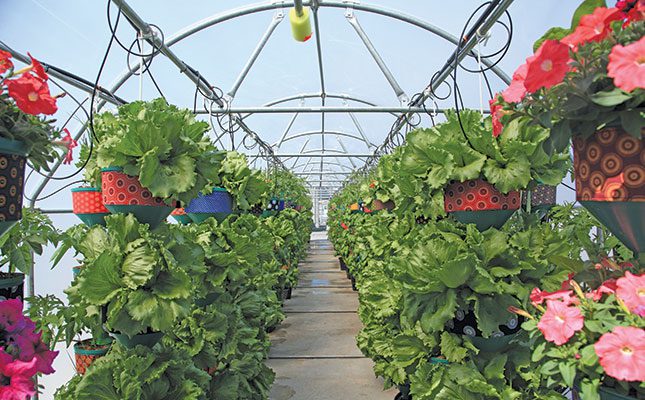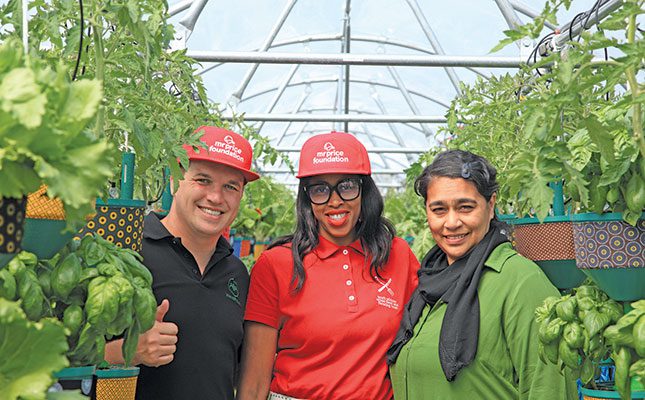
Photo: Glenneis Kriel
Louis-Gillis Janse van Rensburg, founder of Fresh Life Produce, always yearned to have his own business. Reasoning that there was a need for innovative solutions in the agriculture sector and wanting to contribute to food security in South Africa, he finally launched his company in 2016.
His first attempt used an aquaponics production system, but this failed to meet his expectations.
“It was relatively expensive, and needed a constant power supply and high level of skill to operate. I needed something simpler, so that more people could benefit from it,” he recalls.
With the help of his father, Rensie, who worked at the Council for Scientific and Industrial Research, and his mother, Helene, a retired teacher, he went on to design and develop a unique vertical-growing system called the African Grower.
His first major client was the South African National Defence Force, which wanted to upskill its reserve force members and was looking for a way to privatise its kitchens by sourcing food from these growers.
Since then, more than 1 500 African Grower units (‘towers’) have found a place in agricultural programmes across South Africa and Lesotho.
Janse van Rensburg has received several accolades for his innovation. In 2017, he received CapeTalk’s Small Business Award, and in 2018 won a trip to Israel as part of Investec and Ennovate’s agricultural competition.

Two years later, the system won the United Nations Development Programme Cultivate Competition and came second in the French-South African Agricultural Institute’s Innovation Competition.
The system
The African Grower is a vertical-growing system that comprises a ‘tower’ of four vertically stacked recyclable plastic pots. Each tower has the capacity to grow 16 to 24 plants, depending on the space requirements of the cultivated crop.
The box in which the units are packaged serves as a fifth container, which is placed on the ground underneath each unit. Thanks to their generous depth, these units are ideal for the production of root vegetables, such as carrots, potatoes and beetroot, and vegetables with heavy fruit or substantial growth, such as pumpkins, broccoli and cauliflower.
The growth medium used in the system is coconut coir, which has several key advantages.
“It’s compact and light, making it easy to transport, and has excellent water-holding capacity. It’s at least 10 times more water-efficient than soil,” Janse van Rensburg explains.
It can be used to produce a variety of plants for up to nine months, unless the previously cultivated crop suffered from a disease that could spread via the growth medium to other plants.
Water can be supplied via an irrigation system, a hosepipe or a watering can, and
a rate of 500ml water/pot/application is recommended. The key, according to Janse van Rensburg, is to apply enough water at the start of the production cycle to thoroughly wet the growth medium in each pot. From then on, water should be applied at regular intervals to keep the growth medium saturated.
“The water is not recycled, as that would require pumps and additional treatment to prevent build-up of diseases and chemicals.
Each pot, however, drains into the central ‘core’ and out through the bottom of the
tower, making it an isolated growing pod and preventing the spread of diseases. The run-off underneath pours into the container below the tower,” he says.
The growing system is scalable: farmers or households can buy more units as they grow their business or consumption. At the time of writing, a full unit was available for R1 399, and a mini unit, consisting of two pots, for R899.
Janse van Rensburg says he uses money earned from selling the units to partially subsidise units he supplies to community projects.
Fertilisation
HandPicked CityFarm, at Kenilworth Centre in Cape Town, uses the African Grower system as the basis of production.
This rooftop farm, which occupies about 192m², is equipped with six greenhouse tunnels housing African Growers. Two of the tunnels each covers an area of 20m x 3m, while four smaller ones each measures 6m x 3m.
The large tunnels and two of the small ones are used for crop production. The third small tunnel serves as an office and for seedling cultivation, and the fourth is set aside for production trials.
Akhona Gxuluwe, production manager at HandPicked CityFarm, says they use the fertiliser included in the African Grower starter kit as the foundation of their production regime. This a controlled-release fertiliser from the Haifa Group.
“The polymer-coated fertiliser pellets are ‘programmed’ so that different pellets are activated at different times over the production period, which means the plants always have access to all the essential nutrients,” she explains.
A foliar feed called Agri-Boost, which contains essential macro- and micronutrients, is given to the vegetables weekly to prevent any deficiencies in the plants. The rest of the plants are checked for deficiencies and given additional nutrients when the need arises.
Micro-sprinklers are used to supply about 2ℓ of tap water to each tower daily, which translates into roughly five minutes of irrigation a day. The intervals, however, are lengthened to every third day or so in winter when temperatures are lower.
“The coconut coir is a forgiving growth medium, but it has to be checked regularly to ensure it doesn’t dry out, which would lead to production losses,” says Gxuluwe.
Borehole water is available, but it has high salt levels and would have to be filtered before use.
“We’re currently analysing the borehole water and looking at ways to soften it,” she explains.
Crops
Each of the two large tunnels contains 120 African Growers, which translates to 1 920 plants, and each small tunnel has 36 growers carrying 576 plants.
One of the challenges of vertical production systems is that the growth of plants at the bottom is negatively affected by overshadowing from the plants above. According to Gxuluwe, however, this has not yet been a problem in their system.
“We’ll see over time, but I suspect that overshadowing would be a problem with higher towers. The plastic covers of the tunnels also diffuse light, helping to ensure that each pot has access to sufficient light.”
Janse van Rensburg adds that they used an app to work out the movement of the sun over the rooftop, and positioned the tunnels so that the sun passes over the width rather than the length of the tunnels.
They have divided each tunnel into different zones and planted different crops accordingly. Leafy vegetables and herbs that have to be harvested regularly are placed in the two inside rows of the tunnel, while fruit-bearing plants that grow larger and create shade, such as tomatoes, peppers and aubergines, are planted in the outer rows.
The rows are further divided into sections, with winter crops, such as kale and coriander, planted in the first sections, followed by leafy vegetables and herbs, such as lettuce, basil and spinach. The mid-zone is reserved for chillies, as they require more heat and a larger roof space than the other crops.
Challenges
One of Janse van Rensburg’s greatest concerns when they established the rooftop garden was the effect of the strong Cape wind. As they were not allowed to drill any holes into the shopping centre’s roof, he used 200ℓ steel drums filled with water to anchor the tunnels.
“The drums are light when empty, but each weighs about 200kg when filled with water,” he explains.
The tunnels have 40% shade cloth at the back and the front, which allows about 60% of the windflow through the tunnels.
“We’ve had some extreme winds since the tunnels were set up. The tunnels moved a little, but we haven’t suffered any damage or losses so far,” says Janse van Rensburg.
Gxuluwe says that initially they had hoped their isolation on the rooftop would prevent pest or disease problems, but this was soon found not be the case.
“It’s mind-boggling that [any bugs or pathogens] manage to travel all this way through traffic and up to the roof of a building to get to our crops. On the other hand, it also makes sense, as the tunnels are hot and moist, and these conditions favour the development of fungal diseases.
“In addition, we keep the air vents open to control the temperature in the tunnel, and insect pests can crawl through these,” she says.
So far, however, they have had only one incident of black spot on spinach and only two plants were affected. An application of copper helped to address the problem.
Aphids and moths also present a threat, but these pests are controlled with a garlic, chilli and molasses spray.
Janse van Rensburg plans to apply the lessons learnt at HandPicked CityFarm to enhance food production in other communities in South Africa.
Email Louis-Gillis Janse van Rensburg at [email protected].










